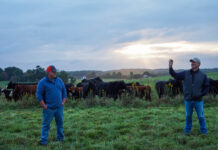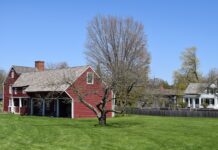Many decades have come and gone since almost every farm maintained and employed a sugar camp.
In my youth I remember the sight of steam rolling away from a lively fire below a large reservoir device in which maple sap was slowly being reduced to syrup.
Well before time for sugar making a farmer and his helpers prepared the site with ample cords of wood, repaired and cleaned necessary buckets, gathering tubs, evaporator spouts and other necessary equipment.
Wintertime. This past winter reminds me and other old timers of what was usual in our youth.
In New England they generally start sugar operations around the first week in March.
My first experience was in the woods near Edinburg, Ohio. The Booth’s and Shelladay’s lived on many farms there about.
Snow was still laying several inches deep in the woods, therefore a horse drawn sleigh was used on every operation.
First we chopped a kerf diagonal cut in the maple tree, remove the chip and insert a tapping iron directly into the trunk, then drive a metal spout into the cut.
In later years an auger was used to bore a hole instead of the chip cutting.
Early sugarmakers. Many metal spouts were formed from old scythe blades by a local blacksmith.
Early sugar makers used a wooden spout whittled from staghorn sumac due to the soft pith in the center of the small limbs which could be easily removed.
The sap was drawn from the inner growth directly under the bark, since any deeper would result in not much sap if any at all.
The placing of buckets to gather sap is quite important – by placing the bucket on the trunk where the limbs are more abundant, or where the largest limbs are, and always placing the taps where there is new growth shows by old bark splitting.
The sap flows to the limbs. The ideal location is often on the southeastern exposure. Both of these considerations may be profitable.
Tapping. When tapping a tree it is suggested not to do so above or below an old taphole. To place it there may injure the tree.
To receive a good flow of sap the temperatures should be similar to the first weeks in March 2003, freezing at night and thawing during daylight.
Cold sap is the best, when an icicle or a trace there of is on the spout a person can well be satisfied.
When the snow is melted and the frost is gone from the soil plus the buds show even the slightest enlargement and growth the sap takes on a bitter taste.
When the sap is drawn after bud growth it is referred to as “bud run” and is usually used in tobacco.
Some trees are like humans, one may give a lot of service (sap) and another very little or one runs quite sweet sap, another similar to just water.
Quality. The quality of sap varies quite a bit from year to year, one year good, the next year quite gritty.
Quantity depends on the operators preference, thin or thick, also it takes often up to 400 buckets to end up with 25-50 gallons of syrup.
From year to year also can be good to disappointment. One year it may flow for almost a month, the next year next to nothing.
Weather change regulates the flow almost every year, a freeze up may halt sap flow or too warm and it is quite short.
Back at camp. Many farms when I was young hauled the full buckets to the camp. I was fortunate due to the wagon on which a big gathering tub was hauled.
The old wooden buckets held more than later metal types, and the wooden bucket often had a stave longer than others into which a stick was placed and then suspended on ropes carried on a shoulder yoke to the camp.
Later metal buckets only held on the average 14 or 15 quarts – about 30 pounds each.
To make sugar, sap was boiled longer than for syrup and at a higher temperature.
My dad and others used to make sap beer, the result of boiling the sap for quite a spell then allow it to ferment.
Accidents happen. There were times when troubles happened at sugar camps. Syrup boiling over fires day and night for weeks can occasionally cause a damaging fire.
The syrup is also quite sticky and hot. My deceased father-in-law, Robert Vickers, was burned quite severely on one arm by spilled hot maple syrup and the scars were present all of his life.
One farmer had a roof with no drop and a large snowfall caused the roof to collapse onto the full boiling reservoir. Needless to say all was lost for market but other helpers and I consumed a lot of solid maple syrup candy.
As a traveler ventures along the byways, many abandoned sugar camp buildings still remain as a memorial to the past early spring sugar making events.
One such can be seen several miles northwest of Salem along Route 14. Many years ago it was quite active on the Martig farm, about 1/4 mile north of county line road on the right.












